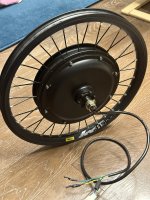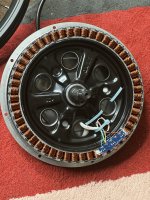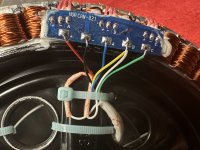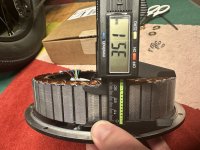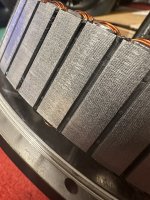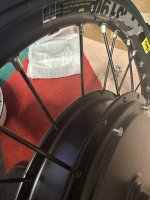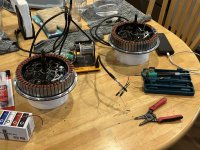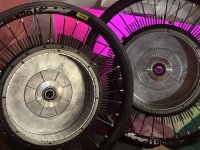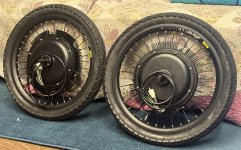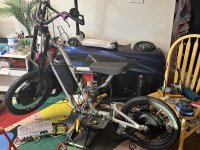chuyskywalker
10 kW
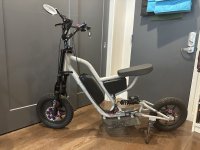
I picked up this frame from Hill Scooters a while back. I've had it in a few different configurations, but haven't quite figured out the right build for it.
In the above picture, I thought I'd get cute and try to "mini" it with some 14" motors. It looks...ok, but you can see I had to install a monsterously long rear suspension to shove the swing arm back to create ground clearance. Also, these motors are...insufficient to the task. I thought they were geared hubs, which would make some nice torque -- I was wrong, they are tiny little direct drive setups.
I'd like to find a motor setup that works and makes this a peppy little fun zip around toy. Speed is not a top priority; anywhere in the 20's is fine. I do not wish to (re)build the battery or change out the controllers. It has a 52v battery with a 14s5p Molicel p26a setup. The battery can comfortably push 100A (technically, 5x35a or about ~175A, but I'm still using the spade connectors on the the battery pack baseplate, so I don't want to go higher.) Still, 50 battery amps per motor is not small potatoes.
The controller is a Spintend 75v100A Dual controller. This can handle providing each motor up to 100 phase amps a piece.
The front fork is a 135mm dropout and the rear swing arm is 150mm; though above I've used some spacers to make the 135mm motor work.
I think I should go back to the 20" wheels this is designed for:
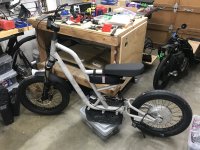
(When I had transplanted some A2B Metro parts onto the frame.)
I'd like some opinions on what motor setup to go with; I've been eyeballing a few options:
- Dual 9C RH212 DD - (motor sim)
Love DD hubs -- quiet, regen, look great, etc. These look like great performers, keep cool, and would likely just be an all around solid option. Also, middle of the pack in price.
- Dual GMAC 10T - (motor sim)
TORRRRRRQUE. Holds that 200lbs of torque longer than the 9c's by a good margin; I've got to believe this would be the more fun ride. They come with the downsides of being noisier and about $200 a piece more expensive. It's also listed at 138mm OLD, which is a smidge too wide for the front, and I'm not sure how much a suspension fork would appreciate that flex.
- Dual Leaf 60v2000w
Lots of praise around these parts about the solid reliability of the leaf motors; especially if you ferro+sink them. By far the cheapest option; no built in temp sensors. Available in any rim (they have these in 16" moto's, 20" fat and 20" skinnies). Don't want to go the fatbike tire route, though, tbh. Likely the heaviest of the bunch; no entry in the motor sim.





